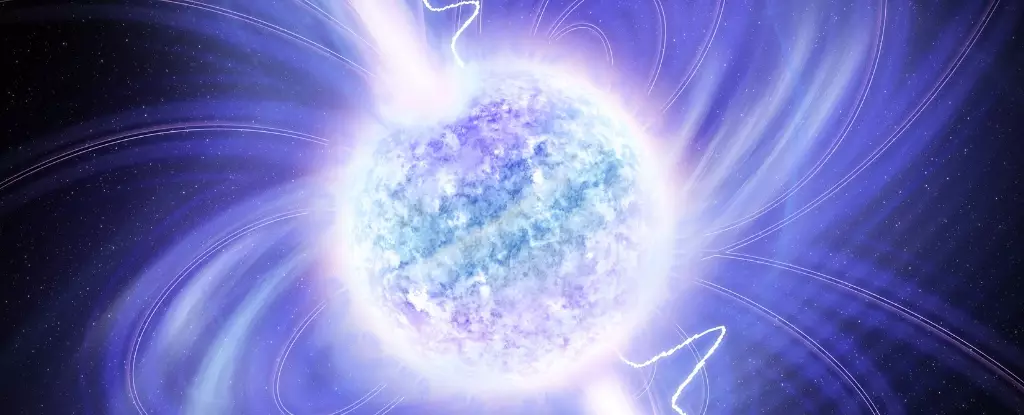Pulsars have long fascinated astronomers, capturing our imagination as stellar lighthouses emitting rhythmic pulses of radio waves. These neutron stars, which spin at astonishing rates, typically complete a full rotation in seconds or even fractions of a second. As they emit beams of radiation that sweep across the cosmos, they exhibit a mesmerizing array of characteristics that have provided key insights into the mysteries of the universe. However, recent discoveries have unveiled peculiar objects that challenge our understanding of pulsar mechanics, particularly those that emit radio signals at remarkably slower intervals.
The latest breakthrough in pulsar research is the identification of ASKAP J1839-0756, an object that takes an astounding 6.5 hours to spin once on its axis. This slow rotation raises fundamental questions about the existing theories surrounding neutron stars, as such behavior was previously deemed impossible. Published in the esteemed journal Nature Astronomy, this discovery showcases the perplexing phenomena occurring in the universe that continue to push the frontiers of astrophysical knowledge.
ASKAP J1839-0756 was located using the Australian Square Kilometer Array Pathfinder (ASKAP) telescope, which is situated in the Wajarri Yamaji country of Western Australia. During a routine observation, astronomers were taken aback when they detected radio emissions from a location that lacked any prior known objects. Notably, these emissions appeared as a fading burst, dropping in brightness by a staggering 95% within only 15 minutes. Initially, scientists were oblivious to the fact that they had stumbled upon an object producing periodic pulses of radio waves.
To delve further into this enigmatic discovery, astronomers conducted extensive follow-up observations using a variety of instruments, including CSIRO’s Australia Telescope Compact Array and the highly sensitive MeerKAT radio telescope in South Africa. Eventually, these observations revealed a periodic pulse pattern, confirming that ASKAP J1839-0756 indeed produced distinct pulses separated by 6.5 hours. This revelation was shocking, as current astronomical theories imply that once a neutron star’s rotation slows beyond a certain point — approximately one cycle per minute — it should cease radio emissions entirely. However, ASKAP J1839-0756, in defiance of these expectations, demonstrates that slow rotation can occur alongside pulsar-like emissions.
An intriguing aspect of ASKAP J1839-0756 is its alignment with Earth, which allows scientists to receive signals from both its magnetic poles. Typically, the majority of pulsars emit signals that can only be detected from one magnetic pole, similar to being illuminated by a one-sided flashlight. A mere 3% of pulsars are known to exhibit a remarkable interplay between their rotation and magnetic axes, allowing for the observation of “interpulses” or secondary emissions from the opposite magnetic pole.
In the case of ASKAP J1839-0756, a secondary pulse appears approximately 3.2 hours after the primary emission. This finding presents an exceptional opportunity to explore the geometry and magnetic field dynamics of neutron stars in scenarios that diverge from established theories. The implications of this interpulse detail raise fresh inquiries regarding whether a pulsar’s magnetic and rotational axes align further or diverge as the rotation slows down.
Among the many questions surrounding ASKAP J1839-0756 is what could be powering this cosmic anomaly. One intriguing proposition is that this object may belong to the category of magnetars, highly magnetized neutron stars exhibiting unique properties that could facilitate radio emissions at slower rotational speeds. Nonetheless, current understanding suggests that even magnetars typically pulsate within seconds, presenting another layer of enigma surrounding this discovery.
Alternatively, some researchers speculate that ASKAP J1839-0756 could potentially be a white dwarf — the remnant core of a star left after it has exhausted its nuclear fuel. While white dwarfs possess slower spin rates compared to neutron stars, no isolated example of a white dwarf emitting radio pulses has been documented thus far. Moreover, concurrent observations across different wavelengths have not yielded any signs of a white dwarf in the same spatial area as ASKAP J1839-0756, leaving its true nature shrouded in mystery.
The peculiarities of ASKAP J1839-0756 prompt a reassessment of our understanding of neutron stars and the mechanisms governing cosmic emissions. As scientists continue to analyze data from this exceptional object, they are reviewing the limits of theoretical astrophysics and the myriad possibilities that the cosmos holds. This discovery not only underscores the potential for unexpected phenomena within our universe, but it is also a reminder of the pressing need for ongoing observation and research, as new signals beckon us to rethink our established narratives about stellar behavior. The universe, with its boundless complexity, continues to surprise and teach us, urging curiosity and discovery at every turn.

